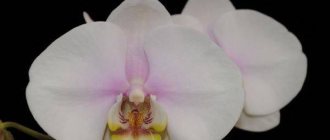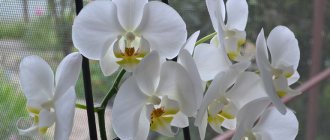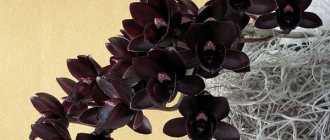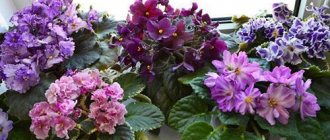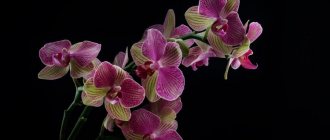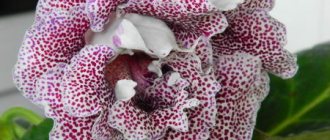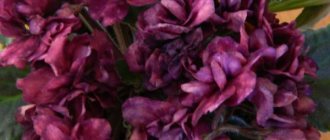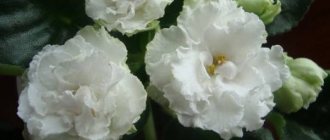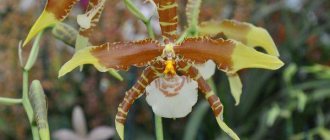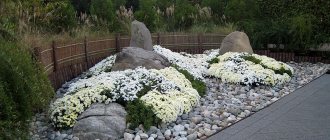Of the many hybrids available commercially, White phalaenopsis orchids are considered the most unpretentious and well adapted to home conditions.
They can easily withstand sharply changing climatic seasonal conditions in the house and have good resistance to many diseases.
In this article we will look at the names of species and varieties of white phalaenopsis, as well as give a brief description of them and describe the features of caring for them. Due to its characteristics, it is the white hybrid that has become the most popular in home growing of orchids.
Variety of varieties
Although white is one of the most popular colors among gardeners, pure white is extremely rare. Basically, it has some color splashes or a different colored edging.
It is believed that the “Amabilis” variety became the progenitor of many varieties and hybrids of this orchid variety. It is impossible to list all the hybrid varieties due to their diversity, but the most popular are:
- "Adelaide"
- "Alabaster";
- "Alaska"
- "Bristol"
- "Cotton Candy";
- "Anthyra Darwin";
- "Christa Wichmann";
- "Cristella"
- "Diamond"
- "Formosa Dream";
- "Gold Lip";
- "Island"
- "Japanese Heart"
- "Kiska"
- "Malibu Chablis";
- "Madonna"
- "Memories"
- "Misty Mountain"
- "Polar Bear"
- "Prima Piano"
- "Ragen"
- "Salt Lake"
- "Samoa"
- "Soft Cloud" etc.
They can have different flower sizes - from large (Royal) to small (mini Mark). The size of the plant itself is also varied, from mini to 1 m.
Choosing containers for Vanda orchid
Not any container is suitable for growing Vanda orchids. Most often, hanging baskets or pots with side holes into which the plant's roots penetrate are chosen. The epiphyte feels as comfortable as possible in them. Recently, the Vanda orchid in a vase has often been on sale. Moreover, there is no substrate in such a container.
Vanda orchid in glass is a great gift idea. You can choose a glass container of any shape for it. This epiphyte looks ideal in tall and spherical vases, flasks and glasses. Unfortunately, orchids that are sold in glass containers with a sealed lid die very quickly.
Names of species and varieties of white phalaenopsis and their photos
Royal
The Royal White Phalaenopsis Orchid is a species with very large flowers . Some specimens reach a diameter of 15 cm.
In principle, care differs little from classical care, but there are still nuances when growing. A more strict attitude towards temperature conditions (22-24 ° C). In autumn, it is better to place it in a room with a temperature of 14 ° for a couple of months, which will stimulate it for the next flowering.
Royal white phalaenopsis.
The pot must be transparent to ensure sufficient light supply to the roots and increase their photosynthesis. Be more responsible when it comes to watering, trying not to over-water or dry out the flower.
Royal Phalaenopsis requires higher indoor humidity . 70-80% would be optimal. Fertilizing also requires a slight increase in dosage. But the main thing here is not to overdo it.
Multiflora
The name Multiflora refers to a small orchid with a large number of buds. Although this name is given for commercial purposes, since such a name does not exist in the scientific literature.
It is distinguished by reduced watering, fertilizing, mainly liquid fertilizers special for orchids. Not so different from classic care, but requires more attention from the owner.
Multiflora variant with white flowers.
Wanda
A distinctive feature of Vanda is its caramel aroma and long flowering. The characteristic differences and features are considered to be a fairly dense stem structure and thick, hanging aerial roots.
Orchid Vanda Tanjanee White.
Peduncles grow from the axils of the leaves. Some aerial roots can grow up to 2 m. In addition, the plant is capable of producing up to 4 flower stalks with 15 flowers on each.
The content is practically no different from the usual for orchids. For a more stable position with such a number of peduncles and large roots, it is better to keep it in a glass pot with drainage holes.
Mini and midi
Mini is a small plant with small leaves, a small number of flowers and peduncles.
White mini phalaenopsis.
Midi - average between mini and standard orchid.
If the mini leaf is up to 9 cm , then the midi is about 15-16 cm , while the standard one is about 20 cm. And, of course, the flowers also differ in size.
Phalaenopsis midi (interior photo).
Butterfly
White butterfly is not a name. This is the common name for white phalaenopsis, whose flowers resemble species of moths or butterflies. Therefore, another concept of a white orchid is the White Butterfly.
White phalaenopsis butterfly.
White Heron
The white heron is called the Habenaria radiata . Its pearly white flower resembles a flying bird. It received this name in Japan, where it is in special demand.
Advice! When growing this type of orchid, you should thoroughly familiarize yourself with the conditions and care for growing it at home.
This type of orchid is quite capricious to care for. Does not tolerate drying out of roots and has a negative attitude towards insufficient lighting. Requires a completely different approach when growing.
White heron.
Watering and feeding Vanda
The Vanda orchid, the care of which involves proper watering, is very sensitive to water conditions. During active growth in spring and summer, the substrate on which the epiphyte grows must be constantly moist. In winter, moderate watering is required. In this case, the plant needs water only when the substrate dries completely. In the hot season, orchids must be sprayed with soft water. Do not allow moisture to get into the axils of the leaves after watering, as this can lead to fungal diseases affecting the plant.
Vanda orichid needs to be fertilized with special fertilizers. They are produced during the period of active growth, budding and flowering. Fertilizers are mixed in required quantities into water for irrigation. As a rule, in the spring-autumn period, fertilizing is carried out weekly. Lack of nutrients in the substrate leads to poor flowering.
You should not be overzealous with fertilizing the soil, since flowers that have received too much fertilizer become weak and elongated. Their top becomes more soft and can bend under the weight of the inflorescence. You should not fertilize sick orchid specimens, as this can only worsen the situation.
External characteristics of Phalaenopsis Amabilis
"Amabilis" is the progenitor of many hybrids growing in nature. It can be found in Borneo, Ambon, Australia, northern Philippines, New Guinea, Java and the Celebes Islands.
Mature plant height
The plant itself is a monopodial epiphyte, stem size from 10 cm to 50 cm , with 4-5 double-rowed, long, elliptical, fleshy leaves.
Phalaenopsis amabilis.
Maximum peduncle length
The flower stalks of an adult plant can reach a meter in length. Depending on the growing conditions, they have an average height of 60 to 90 cm.
It often produces a pair of fairly branched, arched, purple-colored flower stalks at once.
Flower diameter
Typically, 15 flowers develop simultaneously on a peduncle, but an adult plant can bear up to 70 fragrant flowers at the same time.
Their diameter on average ranges from 7 to 9 cm . There are specimens whose diameter can be up to 12-13 cm.
The wide petals and sepals look impressive, having a milky white color with a hint of pink on the outside.
Description of the plant
The Vanda orchid is found in the wild in India, China and Thailand. Its large flowers, reaching 10 cm in diameter, can be painted in a variety of colors. So, on sale you can find various shades of blue, red-violet and pink tones. There are dark mosaic markings across the entire area of the petals, giving this orchid a very attractive appearance.
This plant was named so in 1795 by the Englishman William Jones, who first described the flower during a trip to India. The genus Vanda successfully crosses with the closely related Ascocentrum, which has a more compact size. Thanks to breeding work, today you can find many different interspecific hybrids. Recently, the efforts of flower growers have been aimed at breeding miniature orchids.
Growing in nature
What we see on the shelves in flower shops and centers are artificially bred hybrids , the ancestors of which grow in areas of Southeast Asia in tropical forests saturated with high humidity. These are mainly South China and Indonesia.
This type of orchid received its name in the first quarter of the 19th century from the director of the Leiden Botanical Garden, Karl Blume, who, while on the Malay Archipelago, confused the snow-white phalaenopsis with a flock of white moths.
This is where the name of this amazing flower comes from - the butterfly flower.
Moisture-saturated, dark places with a constant temperature of about 19-27 ° C, which practically does not change seasonally, with nearby swamps, rivers, and streams are the most preferred place for phalaenopsis to grow in the wild.
Tenacious aerial roots entwine the branches and trunks of trees growing in this area. It is these roots that serve the plant as a source of moisture , which they absorb during periods of rain, frequent fog and high air humidity.
Also, the main food is plant residues formed after rotting in the bark of a tree.
Important! Phalaenopsis is an epiphytic plant - it grows on trees, stumps, snags and various ledges.
An orchid is not a parasite, i.e. does not harm the tree. The trunk and branches serve only as a support, making it possible, clinging to the roots, to rise towards the light in the darkened tropical forest.
Reproduction and transplantation of Vanda
These orchids reproduce by separating part of a healthy stem that has aerial roots. Apical cuttings or side shoots are also used. Adult orchid specimens are replanted only when their roots do not fit into the pot or Vanda slows down growth. As a rule, this epiphyte needs to be replanted every 3-4 years. In this case, choose a container for the flower that is not too large, since in such a container it slows down its growth.
For Wanda, they buy a special substrate for orchids. As a last resort, you can prepare the soil mixture yourself. To do this, take 2 parts of pine bark, broken into large pieces, 1 part of perlite/foam chips, ½ part of peat. Pieces of birch charcoal are added to the mixture.
Vanda does not need to trim parts of the plant. In the case when the orchid becomes very tall (long), you can cut off its upper part and plant it in the substrate. Such planting material should have at least 3-4 healthy roots. Tissue sections are sprinkled with crushed coal. The lower part of Vanda eventually produces a “baby” at the base of the epiphyte. For propagation, daughter plants formed in the axils of the leaves are also used. They are simply carefully separated and placed in a separate container.
Features of care
Its unpretentiousness in conditions and care has made the white orchid one of the most popular flowers for home cultivation.
Optimal conditions of detention
The optimal conditions for growing white orchids are:
- diffused light;
- 14 hour daylight hours;
- maintaining the temperature at 22-24°C;
- maintaining humidity (at low humidity, daily irrigation with “rain mist”), avoiding moisture getting into the flower rosette;
- a clear plastic pot with sufficient drainage holes;
- no draft.
Example of a phalaenopsis pot.
Flowering time and dormant period at home
Flower growers should know that predominantly all varieties of white orchids are characterized by long flowering . They also have virtually no rest period. Of course, if conditions are created that are acceptable for her and proper care is provided.
The time of year does not affect the flowering time. Typically, white phalaenopsis blooms for about six months and, after a short break, begins to bloom again.
Watering and fertilizing
One of the important stages when growing any type of orchid is proper watering and timely dosed fertilizing.
Watering is carried out in two ways - watering can and immersion . During the flowering period, it is best to provide watering with a watering can, then the risk of damage to the buds is reduced.
The substrate is saturated with moisture by carefully watering along the edge of the pot once a week. During the dormant period or before flowers appear, use the immersion method, lowering the pot into a container of water for a couple of minutes.
Important! Water for irrigation should be settled, soft and not cold. The optimal water temperature for irrigation is +28 °C. Frequent watering is excluded.
For full development and flowering, additional feeding is necessary. It is produced several times a month with special complex fertilizers for orchids:
- in the summer and during the flowering period it is carried out 2-3 times a month, preferably with a reduced dosage;
- in the cool season, fertilizing is reduced to 1 time per month.
If there are no buds on the peduncle, then fertilizing is not carried out.
Stimulating flowering
An artificially created slight stress condition stimulates phalaenopsis to flower. To do this, the plant is removed to a room with a temperature of about +18 ° for 8-10 hours , and then returned to its usual place with a warm temperature.
You can also use special preparations that stimulate the orchid to form flower stalks. These include: “Bud”, “Plumen”, “Ovary”, etc.
Pruning after flowering
It is recommended to trim the peduncle of white phalaenopsis in two cases:
- If the peduncle is too long, which spoils its aesthetic appearance for the owner, its arrow is shortened;
- When it turns yellow. If this happens, it is cut off completely.
After purchasing in store
Caring for a flower after purchasing it in a store depends on the condition in which you purchased it:
- How does it stay in the pot?
- Is it sustainable?
- Is it blooming or when has it faded?
- Condition of the substrate, etc.
If the substrate is in good condition and the plants in it are sufficiently stable, then replanting is not required. An exception can be considered replacing a flower pot you don’t like.
For acclimatization, it is better to remove the flower for a while in a shaded and well-ventilated place. Usually 3-5 days are enough for the plant to acclimatize to new conditions.
It is worth feeding the orchid with complex fertilizers , reducing the proposed dosage by 2-3 times. Particular attention should be paid to the root system and provide it with proper watering: spilling - drying.
Fertilizing with complex fertilizer.
Attention! In case of a forced transplant, you should purchase a new substrate and create all the necessary conditions.
Prevention of diseases and pests
Experienced orchidists recommend that after purchasing a flower in a store, treat it with a fungicide to prevent diseases. Also carefully examine the root system and remove diseased parts, disinfect the substrate and pot.
When growing, strictly monitor watering, room humidity, temperature, light, etc., since deviation from the required conditions can lead to flower disease.
For preventive measures, timely, dosed fertilizing has proven itself well. They serve to enhance the plant's immune system.
Vanda's diseases
This orchid is susceptible to diseases such as:
- Spotting, which may be caused by excessive moisture in the substrate or air. In diseased plants, wart-like spots form on the underside of the leaf. It is often caused by fungal diseases that actively develop in warm and damp rooms. In this case, rounded black spots appear on the upper side of the leaves. Orchids fight spotting by creating a favorable environment for the flower. When planting plants, the substrate is disinfected. Water Wanda with water in which special antifungal drugs such as Trichodermin or Fitosporin are dissolved.
- Rot caused by waterlogging of the substrate. Most often, the disease progresses on cool days or when using containers that are unsuitable for the orchid. With this disease, rotting of roots and stems is observed. The tissues of the flower soften and turn black. Very quickly the plant turns yellow and dies. To combat this disease, the substrate is disinfected before planting orchids. The plant is watered in accordance with the requirements of agricultural technology. The drug "Maxim" is added to the water.
Changing color at home
A frequent, but still inexplicable from a scientific point of view, phenomenon in which the color of a flower changes. Possible reasons for this phenomenon are explained by the following possible factors:
- artificial coloring by sellers , which wears off over time, is washed off, or for some other reason comes off and returns to its natural color;
- insufficient lighting can provoke a change in brightness and color saturation, which creates a deviation in color;
- oversaturation of expensive complex fertilizers by sellers containing microelements that affect the intensity and richness of flowering. At home, the nutrition gradually loses its strength and the flower takes on its original appearance;
- changes in growing conditions : lighting, rearrangements, stressful moments, all this can affect color changes;
- the natural component is when, as the flower blooms, the color shade changes.
You never know how the bloom will turn out. Will the flowers be large or small, rich in color or dull? Environmental factors, conditions and care present surprises every time.
Vanda orchid pests
These wonderful flowers can be affected by the following pests:
- Thrips, the sign of which is light dots or streaks appearing on the upper side of the leaves. Over time, parts of the plant acquire a whitish tint with a silvery sheen. Affected leaves turn brown and die. Thrips also attack flowers. They become deformed and become stained. To combat these pests, the drugs “Aktara” and “Confidor” are used.
- Scale insects sucking cell sap. Motionless brown insects are visible on parts of the plant. The affected orchid loses color, dries out and dies. Pests are removed by washing the leaves and stem with a soapy sponge. The preparations “Confidor” and “Aktara” are very effective in the fight against scale insects.
Diseases
Fortunately, diseases in the Moon orchid are quite rare, but they necessarily require the intervention of professionals. The most common diseases:
- Leaf spotting . A rather unpleasant, but easily treatable disease. It is imperative to remove the orchid from other flowers. Damaged areas of the flower should be removed; sharp scissors are recommended for this procedure. The resulting sections should be treated with brilliant green, activated charcoal or charcoal. Cinnamon powder also works great;
- Rust . It is a fairly serious disease that is not easy to cure. First of all, it is recommended to rinse the flower under running water. Next you need to replace the soil in the pot. Treatment begins with using a weak solution of potassium permanganate and spraying the plant. A product such as “Manual Orchid” is perfect;
- Root rot . Treatment consists of removing the affected areas of the orchid. They still need to be cut with sharp scissors and treated with charcoal. It is imperative to change the soil, first thoroughly washing and disinfecting the pot, or purchase a new one;
- Fungal diseases . Experienced flower growers recommend using the preparations “Mikosan” or “Topsin” in such cases. You should begin to actively water the substrate and spray the orchid with purchased preparations. The plant does not need urgent transplantation.
Photos of possible orchid diseases.
